Sitemap
A list of all the posts and pages found on the site. For you robots out there, there is an XML version available for digesting as well.
Pages
Posts
Future Blog Post
Published:
This post will show up by default. To disable scheduling of future posts, edit config.yml and set future: false.
Blog Post number 4
Published:
This is a sample blog post. Lorem ipsum I can’t remember the rest of lorem ipsum and don’t have an internet connection right now. Testing testing testing this blog post. Blog posts are cool.
Blog Post number 3
Published:
This is a sample blog post. Lorem ipsum I can’t remember the rest of lorem ipsum and don’t have an internet connection right now. Testing testing testing this blog post. Blog posts are cool.
Blog Post number 2
Published:
This is a sample blog post. Lorem ipsum I can’t remember the rest of lorem ipsum and don’t have an internet connection right now. Testing testing testing this blog post. Blog posts are cool.
Blog Post number 1
Published:
This is a sample blog post. Lorem ipsum I can’t remember the rest of lorem ipsum and don’t have an internet connection right now. Testing testing testing this blog post. Blog posts are cool.
portfolio
Portfolio item number 1
Short description of portfolio item number 1
Portfolio item number 2
Short description of portfolio item number 2 
publications
Paper Title Number 1
Published in Journal 1, 2009
This paper is about the number 1. The number 2 is left for future work.
Recommended citation: Your Name, You. (2009). "Paper Title Number 1." Journal 1. 1(1).
Download Paper | Download Slides | Download Bibtex
Paper Title Number 2
Published in Journal 1, 2010
This paper is about the number 2. The number 3 is left for future work.
Recommended citation: Your Name, You. (2010). "Paper Title Number 2." Journal 1. 1(2).
Download Paper | Download Slides
Paper Title Number 3
Published in Journal 1, 2015
This paper is about the number 3. The number 4 is left for future work.
Recommended citation: Your Name, You. (2015). "Paper Title Number 3." Journal 1. 1(3).
Download Paper | Download Slides
Paper Title Number 4
Published in GitHub Journal of Bugs, 2024
This paper is about fixing template issue #693.
Recommended citation: Your Name, You. (2024). "Paper Title Number 3." GitHub Journal of Bugs. 1(3).
Download Paper
Paper Title Number 5, with math \(E=mc^2\)
Published in GitHub Journal of Bugs, 2024
This paper is about a famous math equation, \(E=mc^2\)
Recommended citation: Your Name, You. (2024). "Paper Title Number 3." GitHub Journal of Bugs. 1(3).
Download Paper
research
Planetary Atmospheric Spectrum Retrieval based on Machine Learning
This project was a course project for the course “Numerical Simulation and AI Forecast of Geophysical Fluids”, with the lecturers being Prof. Qiu Yang and Prof. Xinyu Wen.
Slides (in Mandarin for class presentation)
Report (in Mandarin)
Motivation
It is in principle easy to calculate the transmission and emission spectrum given the atmospheric profile and components based on the theory of radiative transfer. However, the inverse process, which is to retrieve the atmospheric thermodynamic structure and compositions from observed spectrum, turns out to be way harder, as the relation between spectrum and atmospheric status is highly nonlinear. The mainstream approach to address the retrieval problem is the Markov Chain Monte-Carlo (MCMC). As this method requires to calculate the spectrum at every step, it is extremely time consuming and takes a lot of computational resources. AI is apparently an effective way to deal with nonlinear relations, thus it is interesting to utilize the ability of AI to address this problem.
Method
The method can be devided into two parts, i.e. the data preparation and the model training.
Data Preparation
In order to train AI models properly, a dataset with high quality and large number of samples is needed. However, it is difficult to find such dataset. Thus, I decided to generate my own dataset for subsequent AI training process.
The radiative transfer model I chose was pyratbay, a python tool to compute radiative-transfer spectra and fit exoplanet atmospheric properties.
To generate a single set of data with pyratbay, a sequence of operation had to be carried out, including assigning the configuration file for the atmospheric thermal structure and composition, and the configuration of the spectra (type, resolution, etc.).
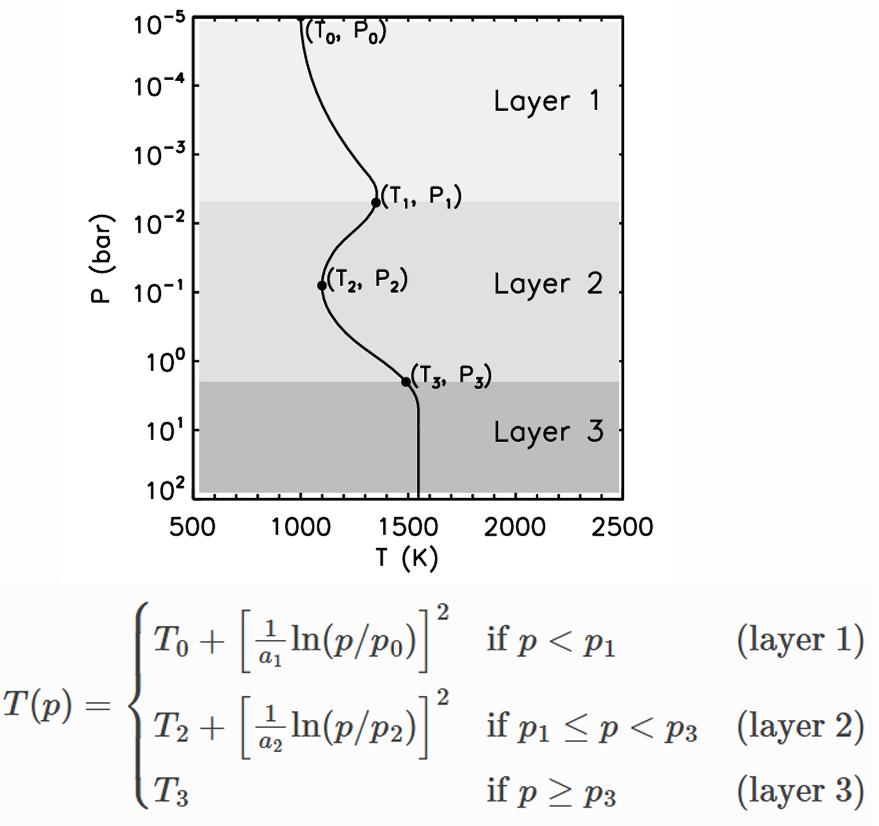
For the atmosphere profile, I used the Madhu profile (Madhusudhan & Seager, 2009) that is inherent in the model (because apparently using a isothermal profile wil give you the trivial blackbody spectrum). For the atmospheric composition, I selected 18 gases, and defined 8 of them as major gases, and the other 10 as minor gases. In summary, there are 24 parameters for each set of data:
- 6 parameters from Madhu profile
- 8 major gases concentration: $H_2O, CO_2, N_2, O_2, CH_4, He, H_2, NH_3$
- 10 minor gases concentration: $O_3, PH_3, CO, SO_2, HCN, H_2S, NO, N_2O, HCl, C_2H_2$
I build a pipeline, utilizing python scripts and shell scripts to generate batches of data. I generated 10800 sets of data in total.
Model Training
I tried 6 models in total: Linear Regression, Random Forest, MLP, 1D CNN, 2D CNN, Transformer.
Stability of Polar Vortices in Planetary Atmospheres
Published:
- Analyzed the stability of planetary polar vortices by conducting 3D simulations and linear stability analysis to identify critical conditions leading to vortex splitting
- Exploring the relationship between vortex instability and atmospheric parameters, with plans to extend the analysis to include various boundary conditions and flow fields
Cloud-Resolving Simulation of Precipitation in Planetary Atmospheres
- Utilized the System for Atmospheric Modeling (SAM) to conduct cloud-resolving simulations of diverse planetary atmospheres
- Analyzed the influence of varying solar spectra and surface gravity on precipitation patterns and atmospheric dynamics
Radiative Effect of Dust on the Climate of Early Mars
Published:
Report (pdf)
Abstract
The climate of early Mars was likely strongly influenced by dust with optical properties distinct from those of modern Mars due to a more reducing ancient environment. In this work, we develop a modeling framework to investigate the radiative effects of such dust. We couple Mie scattering theory with a 1D radiative-convective model to assess the impact of airborne dust, and we use the Hapke model to analyze the spectral reflectance of surface regolith systematically. The framework is validated against modern Mars conditions. Our analysis then yields a key physical insight: the surface albedo is as sensitive to particle effective radius as it is to the material’s intrinsic absorption. This result demonstrates that physical texture is as critical as bulk composition, highlighting that a holistic approach considering mineralogical and physical properties is essential for accurately modeling the climates of early Mars and for the spectral interpretation of rocky exoplanets.
Airborne Dust Scattering
I successfully built a generic pipeline to quantify the radiative impact of airborne dust or aerosol particles that is applicable to various planetary atmospheres.
The calculation takes in the particle’s complex refractive index and size distribution, it then utilizes the Mie scattering theory to calculate the single scattering parameters (extinction coefficient $\beta$, single scattering albedo $\varpi$, asymmetry parameter $g$). The code also includes support to: particle radius distribution, height distribution, and mixing of different particles.
PCM_LBL is a 1D radiative-convective model that simulate the climates of planets. It solves for the radiative transfer and thermodynamic structure of a planetary atmosphere. In this project, I modified the scattering version of PCM_LBL to take in the single scattering parameters ($\beta,\varpi,g$) calculated in the Mie code. The shortwave scattering and absorption, as well as longwave absorption by the dust, are included.
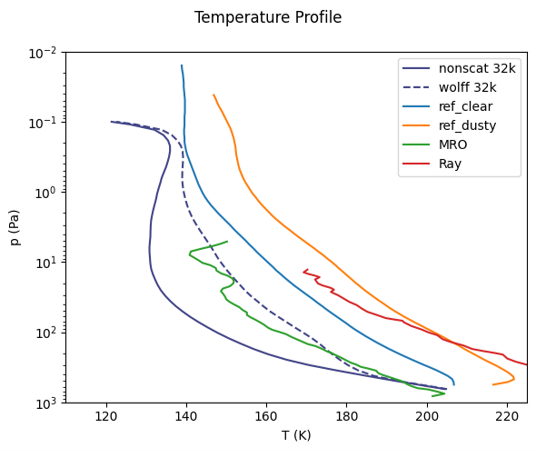
Surface Regolith Albedo
I conducted investigation to several theories concerning particulate media reflectance, including the Shkuratov model, the Hapke model, and the Mishchenko model. In the process, I came up with some critical assessment towards the Shkuratov model. After considering credibility and accessibility, we decided to use the Hapke model for the following work.
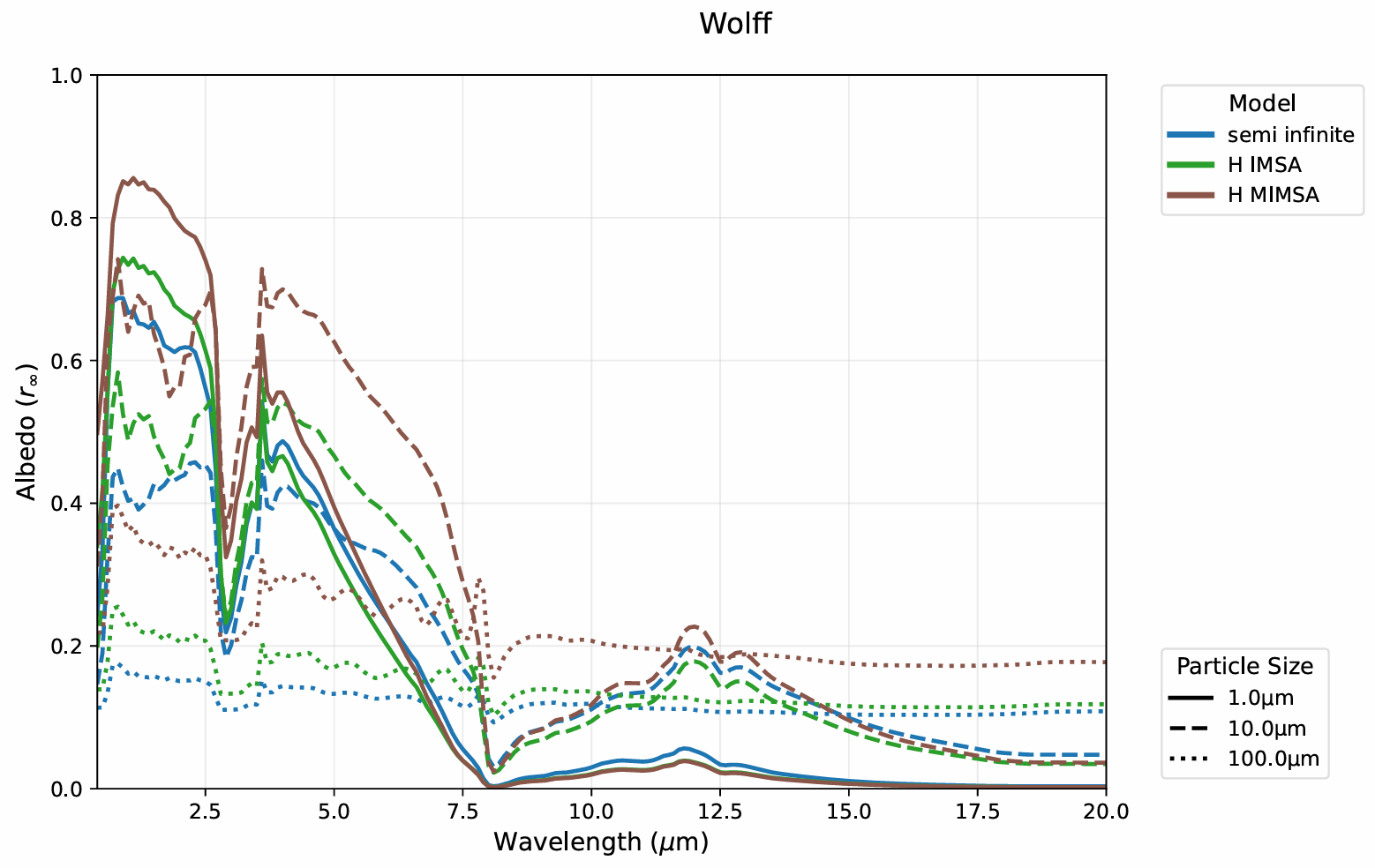
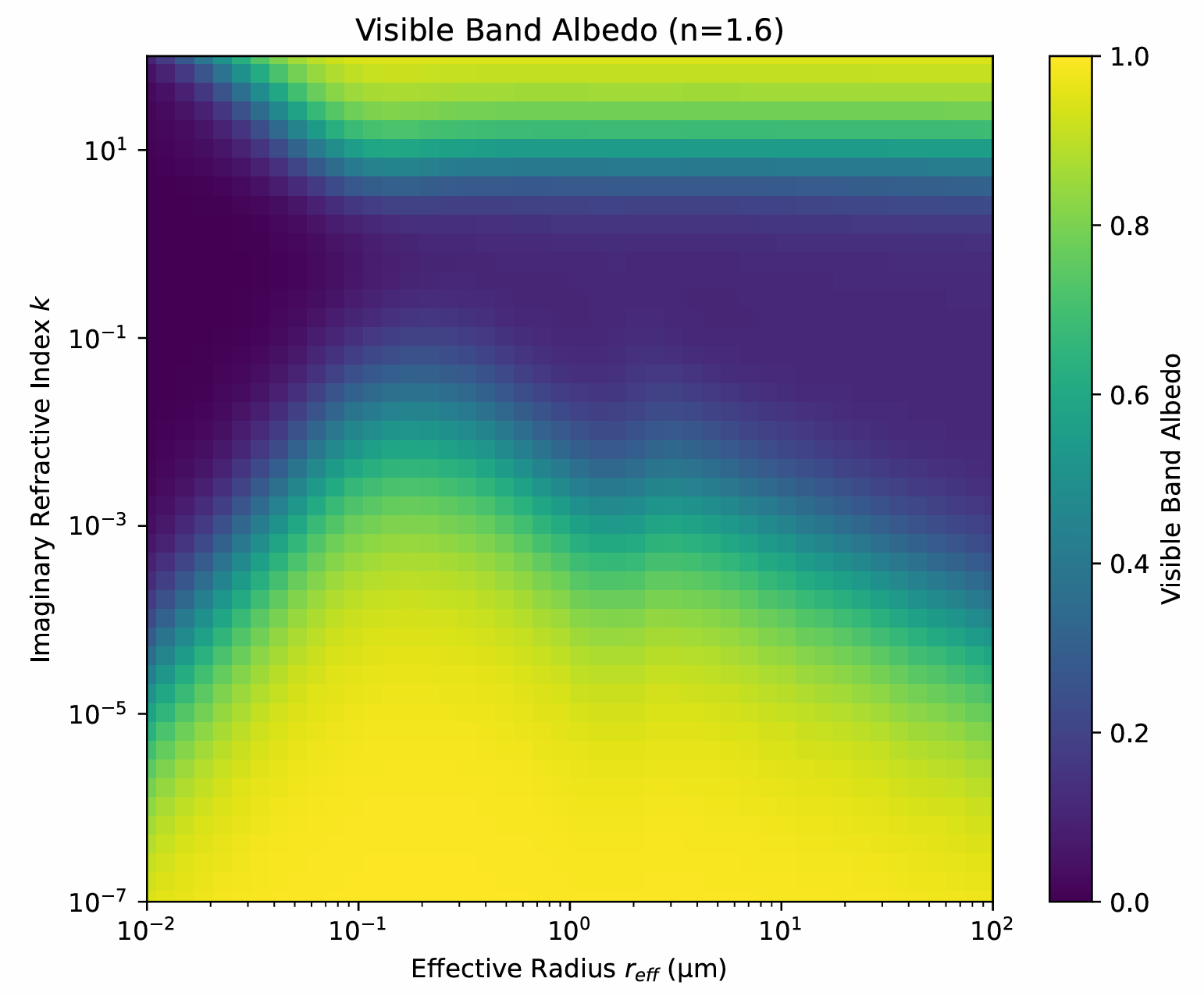
Fig. 2 (b) can be used to illustrate how particle size affects the albedo. From the figure, we can see that for the visible band and typical range of $k,r_{eff}$ ($k<10^0, r_{eff}>10^0\mu\text{m}$), we generally have the albedo larger for smaller $k$ and smaller $r_{eff}$. The impact of particle size is of a comparable order of magnitude to that of $k$. This stresses the importance of determining the radius distribution of the regolith in practical calculations.
Future Work
Comparison with Lab Measurements
To rigorously validate the Hapke model, a key future direction is to perform detailed laboratory measurements. This work will involve preparing rock samples with high-resolution particle size distributions and using a spectrometer to measure their reflectance. This will provide crucial ground-truth data to test and refine the model’s ability to predict macroscopic albedo from the fundamental physical properties of the particles.
Implications for Early Mars
My research highlights that particle size can be as influential as chemical composition in determining planetary albedo, challenging the use of a single, fixed value in early Mars climate models. A crucial next step is to place physical constraints on plausible particle sizes by considering various weathering and fluvial processes on early Mars. This will enable a more dynamic and realistic representation of both surface and airborne dust, refining our understanding of the early Martian climate.
Implications for Exoplanets
The principles of how surface properties shape a planet’s spectrum extend far beyond Mars, with direct applications for exoplanet characterization. By accurately modeling the expected spectra of various bare-rock surfaces, we can establish a critical baseline for astronomical observations. A significant deviation from this baseline, such as an unexpectedly high albedo, could then serve as compelling indirect evidence for the presence of an atmosphere.
Other Interesting Stuff
Colorimetry - From Spectrum to Color
Human eyes have three types of cone cells, each of which has a distinct spectral response function to lights of different wavelengths. The response functions of these three cone cells are $L(\lambda), M(\lambda), S(\lambda)$, representing long to short wavelength. By integrating the spectrum using these corresponding functions as weighing functions, we can get the so-called LMS values, which can be converted into RGB values that can be displayed on a screen.
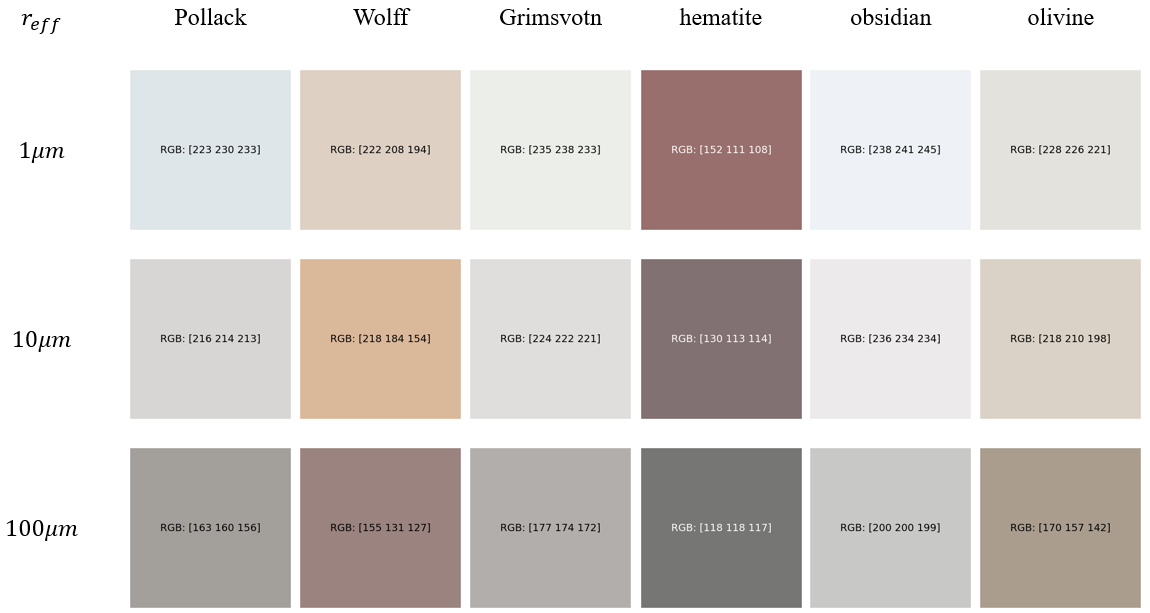
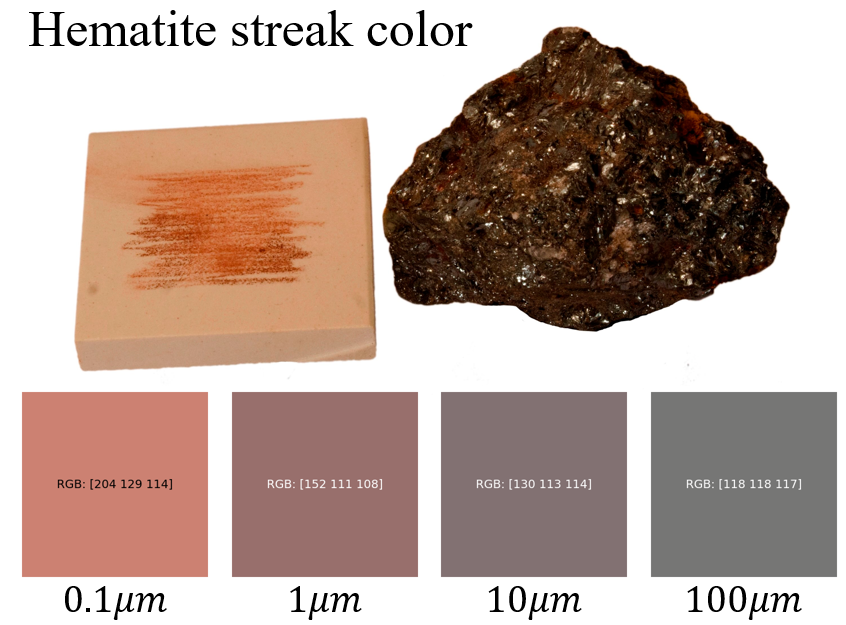
For more information, please refer to this summary report for my 2025 summer research!
talks
2024 Lin-Bridge Exoplanet Symposium
Published:
This is a description of your talk, which is a markdown file that can be all markdown-ified like any other post. Yay markdown!
2024 National Conference in Planetary Sciences
Published:
Test
teaching
TA | Fundamentals of Planetary Science
Undergraduate course, School of Earth and Space Sciences, Peking University, 1900
This course is led by Prof. Jun Yang, offered to freshmen students at the School of Earth and Space Sciences, Peking University. The course covers most of the important parts in the field of planetary sciences, including: stars, orbits, space environment, surface, atmosphere and ocean, interior structure, exoplanets and habitability.
